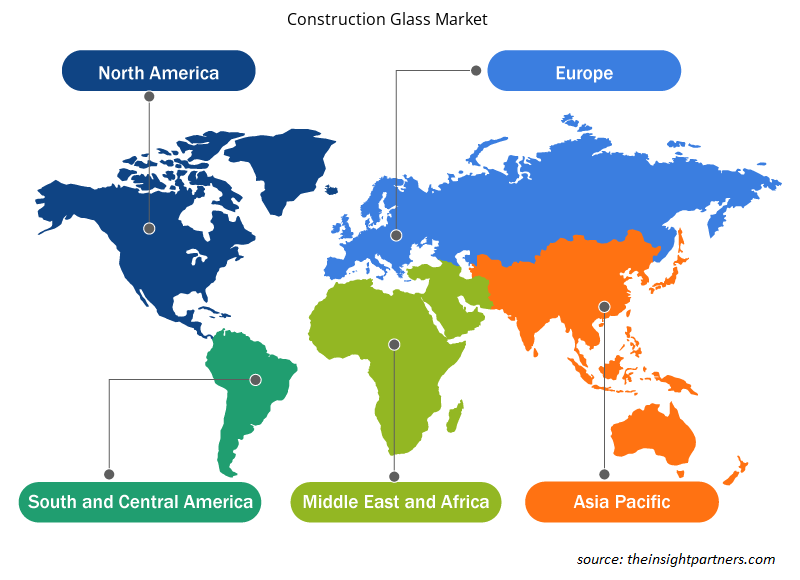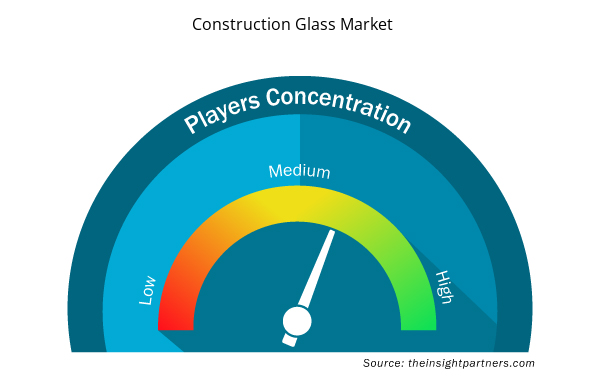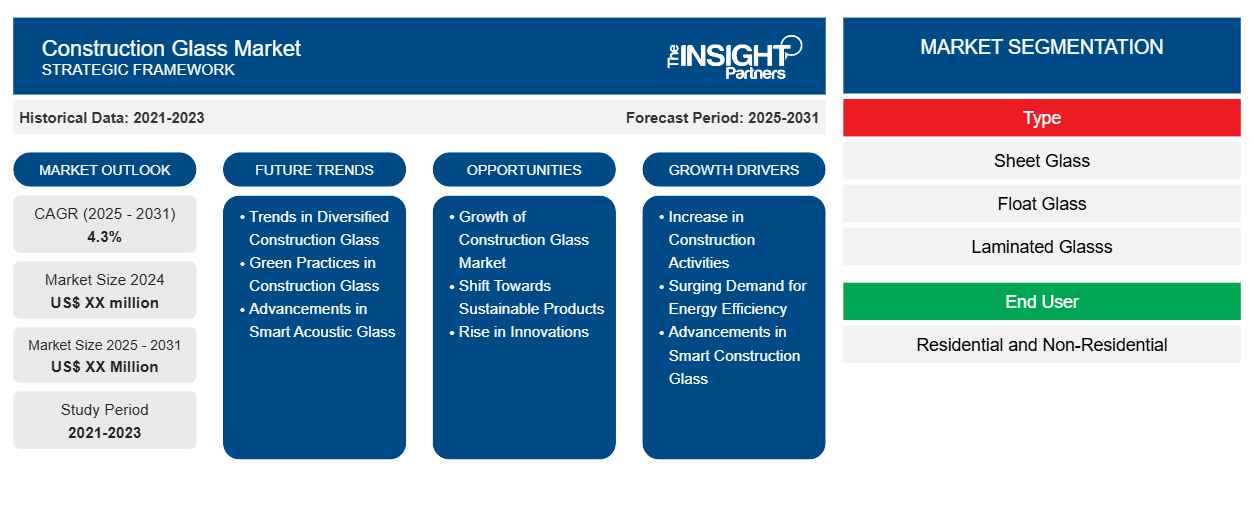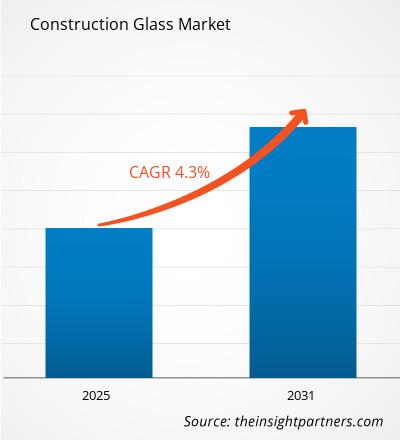من المتوقع أن يسجل سوق زجاج البناء معدل نمو سنوي مركب بنسبة 4.3٪ من عام 2024 إلى عام 2031، مع توسع حجم السوق من XX مليون دولار أمريكي في عام 2024 إلى XX مليون دولار أمريكي بحلول عام 2031.
تم تقسيم التقرير حسب النوع (الزجاج الرقائقي، والزجاج العائم، والزجاج الرقائقي، والزجاج المقاوم للكسر، وغيرها). كما تم تقسيم التقرير حسب المستخدم النهائي (سكني وغير سكني). يغطي نطاق التقرير 5 مناطق: أمريكا الشمالية، وأوروبا، وآسيا والمحيط الهادئ، والشرق الأوسط وأفريقيا، وأمريكا الجنوبية والوسطى والدول الرئيسية في كل منطقة. تم تقسيم التحليل العالمي بشكل أكبر على المستوى الإقليمي والدول الرئيسية. يقدم التقرير القيمة بالدولار الأمريكي للتحليل والشرائح المذكورة أعلاه.
غرض التقرير
يهدف تقرير سوق الزجاج في البناء الصادر عن The Insight Partners إلى وصف المشهد الحالي والنمو المستقبلي وأهم العوامل الدافعة والتحديات والفرص. وسيوفر هذا رؤى لمختلف أصحاب المصلحة في الأعمال التجارية، مثل:
- مزودي/مصنعي التكنولوجيا: لفهم ديناميكيات السوق المتطورة ومعرفة فرص النمو المحتملة، وتمكينهم من اتخاذ قرارات استراتيجية مستنيرة.
- المستثمرون: إجراء تحليل شامل للاتجاهات فيما يتعلق بمعدل نمو السوق، وتوقعات السوق المالية، والفرص المتاحة عبر سلسلة القيمة.
- الهيئات التنظيمية: لتنظيم السياسات ومراقبة الأنشطة في السوق بهدف تقليل الانتهاكات والحفاظ على ثقة المستثمرين والحفاظ على سلامة السوق واستقرارها.
تجزئة سوق زجاج البناء
يكتب
- زجاج صفائحي
- الزجاج العائم
- الزجاج الرقائقي
- زجاج مقاوم للكسر
المستخدم النهائي
- سكنية وغير سكنية
قم بتخصيص هذا التقرير ليناسب متطلباتك
ستحصل على تخصيص لأي تقرير - مجانًا - بما في ذلك أجزاء من هذا التقرير، أو تحليل على مستوى الدولة، وحزمة بيانات Excel، بالإضافة إلى الاستفادة من العروض والخصومات الرائعة للشركات الناشئة والجامعات
- احصل على أهم اتجاهات السوق الرئيسية لهذا التقرير.ستتضمن هذه العينة المجانية تحليلاً للبيانات، بدءًا من اتجاهات السوق وحتى التقديرات والتوقعات.
عوامل نمو سوق زجاج البناء
- زيادة أنشطة البناء: يؤدي النمو المتزايد للمدن وسكانها إلى زيادة الحاجة إلى كل من الإسكان والبناء التجاري. يخلق التوسع الحضري الحاجة إلى استخدام الزجاج في البناء في الواجهات والنوافذ والتحسينات الداخلية. يؤدي هذا إلى اتجاه بين الشركات المصنعة للتوصل إلى منتجات أفضل لمواكبة الهندسة المعمارية الحديثة.
- الطلب المتزايد على كفاءة الطاقة: تعمل العديد من البلدان الآن على فرض لوائح أكثر صرامة بشأن التحكم في كفاءة الطاقة في المباني من أجل منع تغير المناخ. تعد طرق الزجاج الموفرة للطاقة مثل الزجاج العازل أو الزجاج منخفض الانبعاثات جانبًا واضحًا من زجاج البناء في هذه المتطلبات. تتزايد هذه الأعداد مع البحث عن مواد البناء التي ستسمح للبنائين بتلبية التشريعات المعمول بها دون استخدام الكثير من الطاقة في المباني.
- التطورات في زجاج البناء الذكي: يتطور قطاع البناء بسبب التحسينات في إنتاج الزجاج مثل تكنولوجيا الزجاج الذكي وزيادة مقاومة الأوهام المحطمة. وبفضل هذه التطورات، أصبح من الممكن الآن إنشاء زجاج ينظم درجة الحرارة ويمنع أشعة الشمس ويوفر الأمان أيضًا. كما تتقدم صناعة البناء أيضًا حيث يبحث المهندسون المعماريون والبنائون عن خيارات غريبة، وبالتالي فإن زجاج البناء عالي الأداء مطلوب.
اتجاهات مستقبلية في سوق الزجاج المستخدم في البناء
- الاتجاهات في الزجاج المتنوع المستخدم في البناء: يبدو أن سوق الزجاج المستخدم في البناء والهندسة المعمارية يتجه نحو التنوع، حيث تعمل الشركات المصنعة على توسيع نطاق منتجاتها - من أجل الاستجابة للأذواق المتغيرة للعملاء. وتشمل هذه الاتجاهات ظهور أنواع جديدة من الزجاج، مثل الزجاج منخفض الانبعاثية والزجاج الذكي، والتي تم تصميمها لزيادة كفاءة الطاقة وفائدة الهياكل المعاصرة.
- الممارسات الخضراء في زجاج البناء: بالنظر إلى الجوانب المتعلقة بزجاج البناء، فإن الدفع نحو الممارسات المستدامة أصبح أكثر وضوحًا. وبسبب زيادة الوعي البيئي، أصبح البناة والمصممون أكثر اهتمامًا باستخدام المواد الخضراء. وهذا يمثل أيضًا فرصة لتوفر الزجاج المعاد تدويره بالإضافة إلى جميع المواد المعاد تدويرها الأخرى المستخدمة في بناء المباني الخضراء والتي تشكل جزءًا من الحملات العالمية لتعزيز البناء الأخضر.
- التطورات في الزجاج الصوتي الذكي: إن التطورات في الزجاج الصوتي ملحوظة وكذلك التكنولوجيا الذكية المضمنة في الزجاج الإنشائي. على سبيل المثال، يمكن للزجاج الذكي تغيير درجة تعتيمه اعتمادًا على الطقس حيث يسعى إلى تحسين كفاءة الطاقة والراحة للسكان. والسبب في ذلك بسيط؛ حيث يبحث المزيد والمزيد من مطوري العقارات عن التحسينات التي لن تعمل فقط على تحسين أداء المبنى بل ستكون أيضًا جذابة بصريًا.
فرص سوق زجاج البناء
- نمو سوق زجاج البناء: تتمتع سوق زجاج البناء بمجال واسع للنمو في البلدان الناشئة حيث يحدث التوسع الحضري وتطوير البنية التحتية بوتيرة سريعة. تركز آسيا وأفريقيا حاليًا على تطوير القطاعات السكنية والتجارية في بلدانها، مما يؤدي إلى زيادة الاحتياجات إلى زجاج البناء. وقد يؤدي هذا بدوره إلى تعزيز حصة هؤلاء المنتجين في السوق.
- التحول نحو المنتجات المستدامة: مع كون الاستدامة من بين أجندات العديد من البلدان، فإن معدلات منتجات البناء ذات الطبيعة المستدامة في تزايد. يمنح الزجاج المستخدم في البناء الحاصل على شهادة وفقًا لمعايير البناء الأخضر مثل الزجاج منخفض الانبعاثات والزجاج المعاد تدويره الشركات المصنعة فرصة الدخول إلى هذه السوق شديدة التنافسية. وهذا يتماشى أيضًا مع التشريعات التي تشجع البناء الموفر للطاقة ومواد البناء.
- الارتفاع في الابتكارات: إن التقنيات الجديدة في مجال التزجيج مثل الطلاء الذكي والطلاءات الموفرة للطاقة تبشر بنمو جديد. وتعمل مثل هذه الابتكارات على تحسين مستويات راحة المباني والمواد مما يجعلها جذابة للمقاولين. ومع قبول التقنيات الجديدة التي تحددها هذه الأسواق، هناك فرص للشركات لتسويق منتجاتها مما سيؤدي بدوره إلى نتائج أعلى في حصة زجاج البناء.
رؤى إقليمية حول سوق الزجاج المستخدم في البناء
لقد قام المحللون في Insight Partners بشرح الاتجاهات والعوامل الإقليمية المؤثرة على سوق زجاج البناء طوال فترة التوقعات بشكل شامل. يناقش هذا القسم أيضًا قطاعات سوق زجاج البناء والجغرافيا في جميع أنحاء أمريكا الشمالية وأوروبا ومنطقة آسيا والمحيط الهادئ والشرق الأوسط وأفريقيا وأمريكا الجنوبية والوسطى.

- احصل على البيانات الإقليمية المحددة لسوق الزجاج المستخدم في البناء
نطاق تقرير سوق الزجاج المستخدم في البناء
| سمة التقرير | تفاصيل |
|---|---|
| حجم السوق في عام 2024 | XX مليون دولار أمريكي |
| حجم السوق بحلول عام 2031 | XX مليون دولار أمريكي |
| معدل النمو السنوي المركب العالمي (2024 - 2031) | 4.3% |
| البيانات التاريخية | 2021-2023 |
| فترة التنبؤ | 2025-2031 |
| القطاعات المغطاة | حسب النوع
|
| المناطق والدول المغطاة | أمريكا الشمالية
|
| قادة السوق وملفات تعريف الشركات الرئيسية |
|
كثافة اللاعبين في سوق زجاج البناء: فهم تأثيرها على ديناميكيات الأعمال
يشهد سوق زجاج البناء نموًا سريعًا، مدفوعًا بالطلب المتزايد من المستخدم النهائي بسبب عوامل مثل تفضيلات المستهلكين المتطورة والتقدم التكنولوجي والوعي المتزايد بفوائد المنتج. ومع ارتفاع الطلب، تعمل الشركات على توسيع عروضها والابتكار لتلبية احتياجات المستهلكين والاستفادة من الاتجاهات الناشئة، مما يؤدي إلى زيادة نمو السوق.
تشير كثافة اللاعبين في السوق إلى توزيع الشركات أو المؤسسات العاملة في سوق أو صناعة معينة. وهي تشير إلى عدد المنافسين (اللاعبين في السوق) الموجودين في مساحة سوق معينة نسبة إلى حجمها أو قيمتها السوقية الإجمالية.
الشركات الرئيسية العاملة في سوق زجاج البناء هي:
- شركة الصين للزجاج المحدودة
- زجاج أساهي
- سان جوبان
- شركة شوت ايه جي
- شركة شينيي للزجاج المحدودة
إخلاء المسؤولية : الشركات المذكورة أعلاه ليست مرتبة بأي ترتيب معين.

- احصل على نظرة عامة على أهم اللاعبين الرئيسيين في سوق زجاج البناء
نقاط البيع الرئيسية
- التغطية الشاملة: يغطي التقرير بشكل شامل تحليل المنتجات والخدمات والأنواع والمستخدمين النهائيين لسوق الزجاج المستخدم في البناء، مما يوفر صورة شاملة.
- تحليل الخبراء: تم تجميع التقرير على أساس الفهم العميق لخبراء الصناعة والمحللين.
- معلومات محدثة: يضمن التقرير أهمية الأعمال التجارية بسبب تغطيته للمعلومات الحديثة واتجاهات البيانات.
- خيارات التخصيص: يمكن تخصيص هذا التقرير لتلبية متطلبات العملاء المحددة وبما يتناسب مع استراتيجيات العمل بشكل مناسب.
وبالتالي، يمكن أن يساعد تقرير البحث حول سوق الزجاج المستخدم في البناء في تمهيد الطريق لفك شفرة وفهم سيناريو الصناعة وآفاق النمو. ورغم وجود بعض المخاوف المشروعة، فإن الفوائد الإجمالية لهذا التقرير تميل إلى التفوق على العيوب.
- التحليل التاريخي (سنتان)، السنة الأساسية، التوقعات (7 سنوات) مع معدل النمو السنوي المركب
- تحليل PEST و SWOT
- حجم السوق والقيمة / الحجم - عالميًا وإقليميًا وقطريًا
- الصناعة والمنافسة
- مجموعة بيانات Excel



Report Coverage
Revenue forecast, Company Analysis, Industry landscape, Growth factors, and Trends

Segment Covered
This text is related
to segments covered.

Regional Scope
North America, Europe, Asia Pacific, Middle East & Africa, South & Central America

Country Scope
This text is related
to country scope.
الأسئلة الشائعة
Based on geography, Asia Pacific is expected to register the fastest CAGR from 2023 to 2031.
The report can be delivered in PDF/Word format, we can also share excel data sheet based on request.
SCHOTT, Nippon Sheet Glass Co Ltd, Saint-Gobain, Guardian Industries Holdings, Asahi India Glass Ltd, Central Glass Co Ltd, Corning Incorporated, Sisecam, Bendheim, and Pella Corporation are among the leading players operating in the construction glass market.
Rising urbanization is driving the market growth
Growth of green building initiatives is one of the key opportunities for the market growth.
The Construction Glass Market is estimated to witness a CAGR of 4.3% from 2023 to 2031
Trends and growth analysis reports related to Chemicals and Materials : READ MORE..
The List of Companies
- China Glass Holdings Limited
- Asahi Glass
- Saint-Gobain
- Schott AG
- Xinyi Glass Holdings Limited
- Central Glass Co. Ltd.
- PPG Industries, Inc.
- Sisecam Group
- Nippon Sheet Glass Co. LTD.
- Bendheim Glass
The Insight Partners performs research in 4 major stages: Data Collection & Secondary Research, Primary Research, Data Analysis and Data Triangulation & Final Review.
- Data Collection and Secondary Research:
As a market research and consulting firm operating from a decade, we have published and advised several client across the globe. First step for any study will start with an assessment of currently available data and insights from existing reports. Further, historical and current market information is collected from Investor Presentations, Annual Reports, SEC Filings, etc., and other information related to company’s performance and market positioning are gathered from Paid Databases (Factiva, Hoovers, and Reuters) and various other publications available in public domain.
Several associations trade associates, technical forums, institutes, societies and organization are accessed to gain technical as well as market related insights through their publications such as research papers, blogs and press releases related to the studies are referred to get cues about the market. Further, white papers, journals, magazines, and other news articles published in last 3 years are scrutinized and analyzed to understand the current market trends.
- Primary Research:
The primarily interview analysis comprise of data obtained from industry participants interview and answers to survey questions gathered by in-house primary team.
For primary research, interviews are conducted with industry experts/CEOs/Marketing Managers/VPs/Subject Matter Experts from both demand and supply side to get a 360-degree view of the market. The primary team conducts several interviews based on the complexity of the markets to understand the various market trends and dynamics which makes research more credible and precise.
A typical research interview fulfils the following functions:
- Provides first-hand information on the market size, market trends, growth trends, competitive landscape, and outlook
- Validates and strengthens in-house secondary research findings
- Develops the analysis team’s expertise and market understanding
Primary research involves email interactions and telephone interviews for each market, category, segment, and sub-segment across geographies. The participants who typically take part in such a process include, but are not limited to:
- Industry participants: VPs, business development managers, market intelligence managers and national sales managers
- Outside experts: Valuation experts, research analysts and key opinion leaders specializing in the electronics and semiconductor industry.
Below is the breakup of our primary respondents by company, designation, and region:

Once we receive the confirmation from primary research sources or primary respondents, we finalize the base year market estimation and forecast the data as per the macroeconomic and microeconomic factors assessed during data collection.
- Data Analysis:
Once data is validated through both secondary as well as primary respondents, we finalize the market estimations by hypothesis formulation and factor analysis at regional and country level.
- Macro-Economic Factor Analysis:
We analyse macroeconomic indicators such the gross domestic product (GDP), increase in the demand for goods and services across industries, technological advancement, regional economic growth, governmental policies, the influence of COVID-19, PEST analysis, and other aspects. This analysis aids in setting benchmarks for various nations/regions and approximating market splits. Additionally, the general trend of the aforementioned components aid in determining the market's development possibilities.
- Country Level Data:
Various factors that are especially aligned to the country are taken into account to determine the market size for a certain area and country, including the presence of vendors, such as headquarters and offices, the country's GDP, demand patterns, and industry growth. To comprehend the market dynamics for the nation, a number of growth variables, inhibitors, application areas, and current market trends are researched. The aforementioned elements aid in determining the country's overall market's growth potential.
- Company Profile:
The “Table of Contents” is formulated by listing and analyzing more than 25 - 30 companies operating in the market ecosystem across geographies. However, we profile only 10 companies as a standard practice in our syndicate reports. These 10 companies comprise leading, emerging, and regional players. Nonetheless, our analysis is not restricted to the 10 listed companies, we also analyze other companies present in the market to develop a holistic view and understand the prevailing trends. The “Company Profiles” section in the report covers key facts, business description, products & services, financial information, SWOT analysis, and key developments. The financial information presented is extracted from the annual reports and official documents of the publicly listed companies. Upon collecting the information for the sections of respective companies, we verify them via various primary sources and then compile the data in respective company profiles. The company level information helps us in deriving the base number as well as in forecasting the market size.
- Developing Base Number:
Aggregation of sales statistics (2020-2022) and macro-economic factor, and other secondary and primary research insights are utilized to arrive at base number and related market shares for 2022. The data gaps are identified in this step and relevant market data is analyzed, collected from paid primary interviews or databases. On finalizing the base year market size, forecasts are developed on the basis of macro-economic, industry and market growth factors and company level analysis.
- Data Triangulation and Final Review:
The market findings and base year market size calculations are validated from supply as well as demand side. Demand side validations are based on macro-economic factor analysis and benchmarks for respective regions and countries. In case of supply side validations, revenues of major companies are estimated (in case not available) based on industry benchmark, approximate number of employees, product portfolio, and primary interviews revenues are gathered. Further revenue from target product/service segment is assessed to avoid overshooting of market statistics. In case of heavy deviations between supply and demand side values, all thes steps are repeated to achieve synchronization.
We follow an iterative model, wherein we share our research findings with Subject Matter Experts (SME’s) and Key Opinion Leaders (KOLs) until consensus view of the market is not formulated – this model negates any drastic deviation in the opinions of experts. Only validated and universally acceptable research findings are quoted in our reports.
We have important check points that we use to validate our research findings – which we call – data triangulation, where we validate the information, we generate from secondary sources with primary interviews and then we re-validate with our internal data bases and Subject matter experts. This comprehensive model enables us to deliver high quality, reliable data in shortest possible time.


 احصل على عينة مجانية لهذا التقرير
احصل على عينة مجانية لهذا التقرير